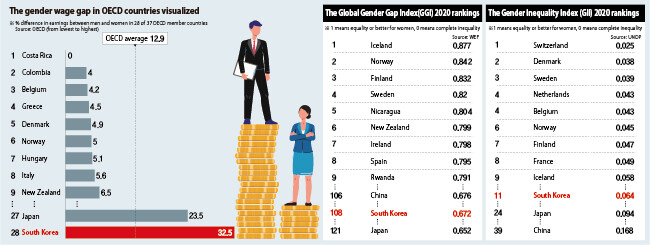hankyoreh
Links to other country sites 다른 나라 사이트 링크
Where does S. Korea stand in terms of gender inequality?

How does South Korea rank globally for gender equality? To answer that question, one may look to the gender equality indexes published by major world organizations, but they can hardly be viewed as absolute standards. The gender equality statistics in different countries may be incomplete, and the rankings can be heavily affected by how that is reflected.
A case in point is the huge difference in South Korea’s ranking according to the UN Development Programme (UNDP) with its Gender Inequality Index (GII) and by the World Economic Forum (WEF) with its Global Gender Gap Index (GGI).
The GII rankings announced last year showed South Korea outperforming other Asian countries, ranking 11th out of 189 countries with a score of 0.064. Yet the GGI ranked it toward the bottom at 108th out of 153 countries. The reason has to do with the different components and methods used to calculate the scores.
South Korea placed high on the UNDP’s GII rankings because of its relatively good performance on two indicators that are reflected as absolute values: a maternal mortality ratio of 11 and an adolescent birth rate (reflecting the number of births per 1,000 women aged 15 to 19) of 1.4.
Commenting on the GII, even the South Korean government acknowledged that it was “limited in its ability to adequately reflect the gender equality level due to the small number of indicators in the area of economic activity.”
“It does not include areas such as the wage gap between men and women, job class segregation in the labor market, time usage differences between men and women, and domestic violence,” it noted.
In contrast, the WEF’s GGI ranking grades the gender gap on a curve. The calculations are based on gender gap indicators such as economic participation rates, literacy and education rates, sex ratio at birth, life expectancy and gender representation in parliament and ministerial positions.
Because the scoring focuses on gender gap phenomenon, a country may rank highly even with low absolute values for both men and women, as long as the difference is relatively small. Among 153 countries examined, South Korea and Japan both ranked in the bottom half at 79th and 144th on the “political empowerment” subindex, based on factors such as representation in parliament and ministerial positions.
In terms of economic participation, it’s worth noting South Korea’s gender wage gap ranking as announced by the Organisation for Economic Co-operation and Development (OECD) based on differences in the median wages for men and women. Here, South Korea placed dead last among 28 countries examined.
This study can’t be called perfect, as the statistics used to investigate wage levels differ slightly by year from one country to the next. But it should also be noted that while South Korea’s healthcare and education environment have improved on the whole, gender disparities in the workplace remain large.
By Cho Ki-weon, staff reporter
Please direct comments or questions to [english@hani.co.kr]

Editorial・opinion
![[Column] Tariffs on China: Trump was dumb, Biden dumber [Column] Tariffs on China: Trump was dumb, Biden dumber](https://flexible.img.hani.co.kr/flexible/normal/500/300/imgdb/original/2024/0520/191716191153918.jpg) [Column] Tariffs on China: Trump was dumb, Biden dumber
[Column] Tariffs on China: Trump was dumb, Biden dumber![[Column] What if Seoul took reunification by force off the table? [Column] What if Seoul took reunification by force off the table?](https://flexible.img.hani.co.kr/flexible/normal/500/300/imgdb/original/2024/0520/3017161928630494.jpg) [Column] What if Seoul took reunification by force off the table?
[Column] What if Seoul took reunification by force off the table?- [Editorial] Intensifying US-China rivalry means Seoul must address uncertainty with Beijing sooner than later
- [Column] When ‘fairness’ means hate and violence
- [Editorial] Yoon must stop abusing authority to shield himself from investigation
- [Column] US troop withdrawal from Korea could be the Acheson Line all over
- [Column] How to win back readers who’ve turned to YouTube for news
- [Column] Welcome to the president’s pity party
- [Editorial] Korea must respond firmly to Japan’s attempt to usurp Line
- [Editorial] Transfers of prosecutors investigating Korea’s first lady send chilling message
Most viewed articles
- 1Xi, Putin ‘oppose acts of military intimidation’ against N. Korea by US in joint statement
- 2Kim Jong-un wanted to meet with residents of shelled Yeonpyeong Island in South, Moon recalls in mem
- 3To weigh costs and benefits, Korea must stop treating US troop presence as a sacred cow
- 4[Column] What if Seoul took reunification by force off the table?
- 5[Column] Tariffs on China: Trump was dumb, Biden dumber
- 6[Editorial] Transfers of prosecutors investigating Korea’s first lady send chilling message
- 7Berlin mayor hints at tearing down ‘comfort women’ memorial in city
- 8[Column] US troop withdrawal from Korea could be the Acheson Line all over
- 9[Editorial] Intensifying US-China rivalry means Seoul must address uncertainty with Beijing sooner t
- 10[Exclusive] Truth commission to seek additional murder charges for figures behind 1980 Gwangju massa